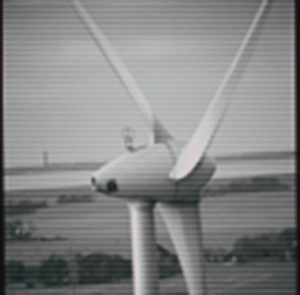I've been admiring Enercon blades for awhile - some are very low speed (17 RPM) and gearbox-free designs that get up to 370 feet diameter. I thought they borrowed many aspects, esp the root area, from great whales. None of the images I surfed off the web have details high enough to see leading edge clearly but a few hint of tubercles. Some show hints of perpendicular grooving after the leading edge though.
Water is 800 thicker than air so I don't think they need to be massive, the open-ocean racing sailboats use 3M films that mimic shark skin to create micro-eddies that reduce friction, Also Speedo (http://tinyurl.com/7jcex) uses braille-like dots above a smooth surface simiarly. I think this could better manage turbulence behind the blades middle and outer 1/3rd..
I am slowly working up a low RPM blade design (1.5m) for a small HV DC motor conversion (12v gives 10rpm) from cedar laminates that will now include tubercles on the root areas - probably the inner 25% with smaller ones added to the next 10% of blade length - THANKS for posting the article!


I also found this article abstract here --> http://tinyurl.com/ex2v5
__Hydrodynamic design of the humpback whale flipper:__
The humpback whale (Megaptera novaeangliae) is reported to use its elongate pectoral flippers during swimming maneuvers. The morphology of the flipper from a 9.02-m whale was evaluated with regard to this hydrodynamic function. The flipper had a wing-like, high aspect ratio planform. Rounded tubercles were regularly interspersed along the flipper's leading edge. The flipper was cut into 71 2.5-cm cross-sections and photographed. Except for sections near the distal tip, flipper sections were symmetrical with no camber. Flipper sections had a blunt, rounded leading edge and a highly tapered trailing edge. Placement of the maximum thickness placement for each cross-section varied from 49% of chord at the tip to 19% at mid-span. Section thickness ratio averaged 0.23 with a range of 0.20-0.28. The humpback whale flipper had a cross-sectional design typical of manufactured aerodynamic foils for lift generation. The morphology and placement of leading edge tubercles suggest that they function as enhanced lift devices to control flow over the flipper and maintain lift at high angles of attack. The morphology of the humpback whale flipper suggests that it is adapted for high maneuverability associated with the whale's unique feeding behavior...